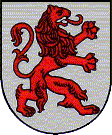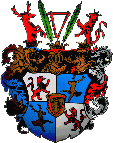
 Duchy of Courland,
Duchy of Courland,1561-1795

 Duchy of Courland,
Duchy of Courland,Several parts of Courland area did not belong to the Duchy. Grobina district (at the coast of Baltic Sea) was loaned to duke of Prussia already by the Order of Livonia. Another district, the Bishopric of Piltene, named also the Bishopric of Courland (at Venta River in western Courland), belonged to Magnus, the king of Denmark. He promised to transfer it to Duchy of Courland after his death. But this plan failed and only later Wilhelm Kettler regained this district.
When Gotthard Kettler died, his sons, Friedrich and Wilhelm, became the dukes of Courland. They divided Duchy into 2 parts in 1596. Friedrich owned eastern part, Semigalia (Zemgale), with his residency in Jelgava (Mittau). Wilhelm owned western part, Courland (Kurzeme), with his residency in Kuldiga (Goldingen). Wilhelm regained back Grobina district, when he married daughter of duke of Prussia. He also paid out and regained control over Piltene district. Here he developed metalworking, shipyards, and the new ships delivered goods of Courland to another countries.
However, the relations between the duke and landowners were quite hostile. In addition to that Poland, the higher superior of Duchy of Courland, was supporting these landowners. Wilhelm expressed his disappointment with landowners, but this ended-up with his removal from duke's seat in 1616. Finally Wilhelm left Courland and spent the rest of his life abroad. Thus, Friedrich became the only duke of Courland since 1616. During 1600-1629, there was the war between Poland and Sweden with its main battlefields around Riga. As the result of this war, Sweden controlled central and north part of Latvia, Swedish Livonia. Poland had the eastern part of Duchy of Livonia, since then called Inflantia. Courland was also involved into this war, but had no severe damage.
Under the next duke, Jacob Kettler, Duchy reached its top prosperity. During his travels to Western Europe, Jacob became the eager defender of mercantile ideas. The metalworking and ship building was developed much more. Also the powder mills, producing the gunpowder, were established. The trading relations were established not only with the near countries, but also with Great Britain, France, Netherlands, Portugal, e.t.c. Jacob established the merchant fleet of Duchy with main harbours in Ventspils, Liepaja. In 1651 Duchy even gained its first colony in Africa, St. Andrews Island at Gambia River and established Jacob Fort there. The main export goods were ivory, gold, furs, spices. Soon, 1652, another colony was established in Tobago Island, British Westindies. There the main export goods were sugar, tobacco, coffee and spices. However, all this time Duchy of Courland was the point of interest for both Sweden and Poland. In 1655 Swedish army entered territory of Duchy and the Swedish - Polish war (1655-1660) begun. Duke Jacob was captured by Swedish army in 1658-1660. During this period both colonies were taken by Dutch colonists, the merchant fleet and factories were destroyed. This war ended with the Treaty of Peace at Oliv (near Danzig). Tobago was regained again just for a short period at the end of rule of Jacob. He began to restore the fleet and factories, but Duchy never again reached its prosperous level as it was until 1655.
When Jacob died in 1682, his son, Friedrich Casimir, was the next duke. During his reign the production continued to decrease. Duke himself was more worried to enjoy glamorous celebrations and for these reasons spent more money, than it was possible. Thus, he also had to sell Tobago to British colonists. He died at 1698. During this period Poland increased its influence in political and economical life of Duchy. Also Russia expressed its interests in this area. The next Duke was only 6 years old in 1698, and he was under regency of his uncle Ferdinand - Polish general. During this time the Northern War (1700-1721) began between Sweden and Russia with its allies - Poland, Saxony and Denmark. In fact, the central part of Latvia was controlled by Russia since 1710. It had a strong influence also concerning Duchy of Courland. Tsar of Russia, Peter the Great, received a promise from Friedrich Wilhelm, that he will marry one of the daughters of Peter's brother. By having this promise, Peter the Great wished to increase the influence of Russia in Courland. So, in 1711 Friedrich Wilhelm married to Anna Ivanovna (later Empress of Russia), but on his way back from St.Petersburg, he got sick and died.
After his death the next candidate for the seat of duke was Ferdinand Kettler, but his residence was in Danzig. The Council of Duke did not recognize him, because according to the rules, duke had to reside in territory of Duchy. So, in fact, actually there was not duke in Courland. Because Ferdinand was the last representative of Kettler's family, a remarkable amount of candidates tried to gain the seat of duke during this period. A good chance had Moritz, the count of Saxony, son of August, king of Poland. Russia disliked this and sent an army to western Courland to destroy Moritz's base. As the result Moriz had to leave Courland and Russia increased its influence even more in Courland. When Anna Ivanovna, the wife of Ferdinand, became the Empress of Russia, her candidate, Ernst Biron became the duke of Courland.
He received remarkable financial support from Russia and invested it into the construction. An example here is the castle of Rundale projected by the distinguished Italian architect Rastrelli. Anna Ivanovna died in 1740 and then occurred the change of persons, having their influence in political life in Russia. Duke Ernst Biron was sent to exile. Also from there, through the Council of Duke, he continued to control the Duchy, having accept from the king of Poland. However, landowners of Courland disliked that and even refused to follow the regulations of the Council of Duke. The king of Poland gave up against the landowners of Courland and announced his son, Carl, the count of Saxony, as the next duke. Thus, Duchy of Courland had 2 dukes simultaneously since then. Situation was extremely tense - part of landowners accepted Ernst Biron, part - Carl of Saxony. The Empress of Russia, Catherine II solved this situation by recalling Ernst Biron back from exile in 1763. By doing this, she avoided the possible increase of Poland's influence in Courland. However, Ernst Biron felt tired from all these political fights and turned the seat of duke to his son, Peter Biron, in 1769.
Still the political activities were quite strong in Courland. Part of landowners supported Poland, part - Russia. In fact, the further faith of Courland was decided, when Russia with its allies began the 3rd division of Poland. Having a "nice recommendation" of Russia, duke Peter Biron gave up his rights to Russia in 1795. By signing the final document in March 28 1795, the Duchy of Courland did not exist anymore.
Friedrich Wilhelm Kettler, 1698-1711 (There was not any coinage)
Ferdinand Kettler, 1711-1737 (There was not any coinage)
Ernst Johann Biron, 1737-1740 (There was not any coinage)
The Council of Duke, 1740 - 1758 (There was not any coinage)
![]() Gotthard Kettler, 1561-1587
Gotthard Kettler, 1561-1587
![]() Friedrich, (1587-1642) & Wilhelm (1587-1616), Kettlers
Friedrich, (1587-1642) & Wilhelm (1587-1616), Kettlers
![]() Friedrich Casimir Kettler, 1682-1698
Friedrich Casimir Kettler, 1682-1698
If any comments, ideas or questions, let me know.
![]()
This page hosted by ![]() Get your own Free Home Page
Get your own Free Home Page